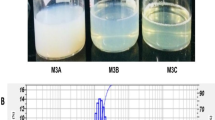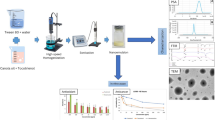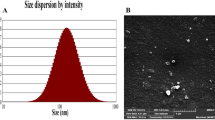Abstract
The utilisation of medicinal plants and their essential oils is receiving more attention due to the ineffectiveness of current therapeutic methods in the treatment of various cancers and the rising incidence of bacterial antibiotic resistance. Thymol, an active ingredient of Thymus vulgaris, is known to have hepatoprotective, antibacterial, and antioxidant properties. To overcome major obstacles to their usage, such as quick oxidation and high volatility, plant essential oils must be administered through a system to improve the delivery of their active pharmaceutical ingredient. The bioavailability of active substances may be enhanced by the colloidal dispersion nanoemulsion. Therefore, this study aims to derive a comparative evaluation of the thyme oil nanoemulsion formulation and the characterisation of its antibacterial and antitumorigenic activities. A nanoemulsion (NE) with a droplet size of 122.2 ± 1.079 nm was discovered to be stable and mono-dispersed for 4 months and inhibited the growth of B. subtilis, E. coli, P. aeruginosa, and S. aureus. It also displayed antitumorigenic capabilities in HepG2 cells by arresting the cell cycle in the G2/M phase and upregulating the gene expression levels of Bcl-2-associated X protein (Bax), Caspase 3, 8, and 9, as well as a concomitant concentration-dependent decrease in B-cell leukaemia/lymphoma 2 protein (BCL2). Along with an increase in inducible nitric oxide synthase (iNOS) levels, upregulation of the expression levels of the reactive oxygen species (ROS), mitogen-activated protein kinase (MAPK), and endoplasmic reticulum (ER) stress pathways was also seen, indicating of ROS formation in the cancer cells.
Graphical Abstract










Similar content being viewed by others
Data Availability
Data will be available on a reasonable request.
References
Pan, S.-Y., Litscher, G., Gao, S.-H., Zhou, S.-F., Yu, Z.-L., Chen, H.-Q., Zhang, S.-F., Tang, M.-K., Sun, J.-N., & Ko, K.-M. (2014). Historical perspective of traditional indigenous medical practices: The current renaissance and conservation of herbal resources. Evidence-Based Complementary and Alternative Medicine, 2014, 20, Article ID 525340. https://doi.org/10.1155/2014/525340
Hileman, B. (2007). Food irradiation. Chemical & Engineering News, 85(3), 41–43.
El-Sayed, S. M., & El-Sayed, H. S. (2021). Antimicrobial nanoemulsion formulation based on thyme (Thymus vulgaris) essential oil for UF labneh preservation. Journal of Materials Research and Technology, 10, 1029–1041.
Sampaio, C. I., Bourbon, A. I., Gonçalves, C., Pastrana, L. M., Dias, A. M., & Cerqueira, M. A. (2022). Low energy nanoemulsions as carriers of thyme and lemon balm essential oils. LWT, 154, 112748.
Burt, S. (2004). Essential oils: Their antibacterial properties and potential applications in foods—A review. International Journal of Food Microbiology, 94(3), 223–53.
Bakkali, F., Averbeck, S., Averbeck, D., & Idaomar, M. (2008). Biological effects of essential oils–A review. Food and Chemical Toxicology, 46(2), 446–75.
Cosentino, S., Barra, A., Pisano, B., Cabizza, M., Pirisi, F. M., & Palmas, F. (2003). Composition and antimicrobial properties of Sardinian Juniperus essential oils against foodborne pathogens and spoilage microorganisms. Journal of Food Protection, 66(7), 1288–91.
Nielsen, C. K., Kjems, J., Mygind, T., Snabe, T., Schwarz, K., Serfert, Y., et al. (2017). Antimicrobial effect of emulsion-encapsulated isoeugenol against biofilms of food pathogens and spoilage bacteria. International Journal of Food Microbiology, 242, 7–12.
Carson, C. F., & Hammer, K. A. (2011). Chemistry and bioactivity of essential oils. Lipids Essent Oils Antimicrob Agents, 25, 203–238.
Peter, K. V. (2006). Handbook of herbs and spices: Volume 3: Woodhead publishing.
Siani, A., Ramos, Md. S., Menezes-de-Lima, O., Jr., Ribeiro-dos-Santos, R., Fernadez-Ferreira, E., Soares, R., et al. (1999). Evaluation of anti-inflammatory-related activity of essential oils from the leaves and resin of species of Protium. Journal of Ethnopharmacology, 66(1), 57–69.
Kowalczyk, A., Przychodna, M., Sopata, S., Bodalska, A., & Fecka, I. (2020). Thymol and thyme essential oil—New insights into selected therapeutic applications. Molecules, 25(18), 4125.
Hammoudi Halat, D., Krayem, M., Khaled, S., & Younes, S. (2022). A focused insight into thyme: Biological, chemical, and therapeutic properties of an indigenous Mediterranean herb. Nutrients, 14(10), 2104.
Kumari, S., Kumaraswamy, R., Choudhary, R. C., Sharma, S., Pal, A., Raliya, R., et al. (2018). Thymol nanoemulsion exhibits potential antibacterial activity against bacterial pustule disease and growth promotory effect on soybean. Scientific Reports, 8(1), 1–12.
Johny, A. K., Darre, M., Donoghue, A., Donoghue, D., & Venkitanarayanan, K. (2010). Antibacterial effect of trans-cinnamaldehyde, eugenol, carvacrol, and thymol on Salmonella Enteritidis and Campylobacter jejuni in chicken cecal contents in vitro. Journal of Applied Poultry Research, 19(3), 237–244.
Escobar, A., Perez, M., Romanelli, G., & Blustein, G. (2020). Thymol bioactivity: A review focusing on practical applications. Arabian Journal of Chemistry, 13(12), 9243–9269.
Liu, Q., Meng, X., Li, Y., Zhao, C.-N., Tang, G.-Y., & Li, H.-B. (2017). Antibacterial and antifungal activities of spices. International Journal of Molecular Sciences, 18(6), 1283.
Cai, C., Ma, R., Duan, M., & Lu, D. (2019). Preparation and antimicrobial activity of thyme essential oil microcapsules prepared with gum arabic. RSC Advances, 9(34), 19740–7.
Boskovic, M., Zdravkovic, N., Ivanovic, J., Djordjevic, J., Janjic, J., Pavlicevic, N., et al. (2016). Inhibitory effect of thyme and oregano essential oils and some essential oil components on Salmonella Senftenberg and Salmonella Give. Scientific Journal “Meat Technology,” 57(1), 71–5.
Oliveira, M. MMd., Brugnera, D. F., & Piccoli, R. H. (2013). Essential oils of thyme and Rosemary in the control of Listeria monocytogenes in raw beef. Brazilian Journal of Microbiology, 44(4), 1181–1188.
Miladi, H., Slama, R., Mili, D., Zouari, S., Bakhrouf, A., & Ammar, E. (2013). Essential oil of Thymus vulgaris L. and Rosmarinus officinalis L.: Gas chromatography-mass spectrometry analysis, cytotoxicity and antioxidant properties and antibacterial activities against foodborne pathogens. Natural Science, 5, 729–739. https://doi.org/10.4236/ns.2013.56090
Quendera, A. P., Barreto, A. S., & Semedo-Lemsaddek, T. (2019). Antimicrobial activity of essential oils against foodborne multidrug-resistant enterococci and aeromonads in planktonic and biofilm state. Food Science and Technology International, 25(2), 101–108.
Kuete, V. (2017). Thymus vulgaris. Medicinal spices and vegetables from Africa, 599–609.
Hayouni, E. A., Bouix, M., Abedrabba, M., Leveau, J.-Y., & Hamdi, M. (2008). Mechanism of action of Melaleuca armillaris (Sol. Ex Gaertu) Sm. essential oil on six LAB strains as assessed by multiparametric flow cytometry and automated microtiter-based assay. Food Chemistry, 111(3), 707–18.
Anton, N., Benoit, J.-P., & Saulnier, P. (2008). Design and production of nanoparticles formulated from nano-emulsion templates—A review. Journal of Controlled Release, 128(3), 185–99.
Chen, H., Zhang, Y., & Zhong, Q. (2015). Physical and antimicrobial properties of spray-dried zein–casein nanocapsules with co-encapsulated eugenol and thymol. Journal of Food Engineering, 144, 93–102.
El Asbahani, A., Miladi, K., Badri, W., Sala, M., Addi, E. A., Casabianca, H., et al. (2015). Essential oils: From extraction to encapsulation. International Journal of Pharmaceutics, 483(1–2), 220–43.
Donsì, F., Annunziata, M., Vincensi, M., & Ferrari, G. (2012). Design of nanoemulsion-based delivery systems of natural antimicrobials: Effect of the emulsifier. Journal of Biotechnology, 159(4), 342–50.
Rodríguez, J., Martín, M. J., Ruiz, M. A., & Clares, B. (2016). Current encapsulation strategies for bioactive oils: From alimentary to pharmaceutical perspectives. Food Research International, 83, 41–59.
Weiss, J., Gaysinsky, S., Davidson, M., McClements, J. (2009). Nanostructured encapsulation systems: Food antimicrobials. In Global issues in food science and technology (pp. 425–79). Elsevier.
Solans, C., Izquierdo, P., Nolla, J., Azemar, N., & Garcia-Celma, M. J. (2005). Nano-emulsions. Current Opinion in Colloid & Interface Science, 10(3–4), 102–10.
Sharifi-Rad, M., Varoni, E. M., Iriti, M., Martorell, M., Setzer, W. N., del Mar, C. M., et al. (2018). Carvacrol and human health: A comprehensive review. Phytotherapy Research, 32(9), 1675–1687.
Islam, M. T., Khalipha, A. B., Bagchi, R., Mondal, M., Smrity, S. Z., Uddin, S. J., et al. (2019). Anticancer activity of Thymol: A literature-based review and docking study with emphasis on its anticancer mechanisms. IUBMB Life, 71(1), 9–19.
Nagoor Meeran, M. F., Javed, H., Al Taee, H., Azimullah, S., & Ojha, S. K. (2017). Pharmacological properties and molecular mechanisms of thymol: Prospects for its therapeutic potential and pharmaceutical development. Frontiers in Pharmacology, 8, 380.
Ahmad, A., Saeed, M., & Ansari, I. A. (2021). Molecular insights on chemopreventive and anticancer potential of carvacrol: Implications from solid carcinomas. Journal of Food Biochemistry, 45(12), e14010.
Mansuri, A., Chaudhari, R., Nasra, S., Meghani, N., Ranjan, S., & Kumar, A. (2023). Development of food-grade antimicrobials of fenugreek oil nanoemulsion—Bioactivity and toxicity analysis. Environmental Science and Pollution Research, 30(10), 24907–24918.
Meghani, N., Patel, P., Kansara, K., Ranjan, S., Dasgupta, N., Ramalingam, C., et al. (2018). Formulation of vitamin D encapsulated cinnamon oil nanoemulsion: Its potential anti-cancerous activity in human alveolar carcinoma cells. Colloids and Surfaces B: Biointerfaces, 166, 349–357.
Moghimi, R., Ghaderi, L., Rafati, H., Aliahmadi, A., & McClements, D. J. (2016). Superior antibacterial activity of nanoemulsion of Thymus daenensis essential oil against E. coli. Food Chemistry, 194, 410–5.
Pratap-Singh, A., Guo, Y., Lara Ochoa, S., Fathordoobady, F., & Singh, A. (2021). Optimal ultrasonication process time remains constant for a specific nanoemulsion size reduction system. Scientific Reports, 11(1), 1–12.
Khameneh, B., Eskin, N. M., Iranshahy, M., & Fazly Bazzaz, B. S. (2021). Phytochemicals: A promising weapon in the arsenal against antibiotic-resistant bacteria. Antibiotics, 10(9), 1044.
DiPaola, R. S. (2002). To arrest or not to G2-M Cell-cycle arrest: Commentary re: AK Tyagi et al., Silibinin strongly synergizes human prostate carcinoma DU145 cells to doxorubicin-induced growth inhibition, G2-M arrest, and apoptosis. Clin. Cancer Res., 8: 3512–3519, 2002. Clinical Cancer Research, 8(11), 3311–3314.
Lambert, R., Skandamis, P. N., Coote, P. J., & Nychas, G. J. (2001). A study of the minimum inhibitory concentration and mode of action of oregano essential oil, thymol and carvacrol. Journal of Applied Microbiology, 91(3), 453–62.
Funding
This work was supported by the Gujarat Institute for Chemical Technology (GICT) (AU/DBLS/GICT-nanomaterials/2016-17/01) for the funding and has been acknowledged for the establishment of a facility for environmental risk assessment of chemicals and nanomaterials.
Author information
Authors and Affiliations
Contributions
All authors contributed to the study’s conception and design. Nanoemulsion preparation, data collection, and analysis were performed by Simran Nasra. The first draft of the manuscript was written by Simran Nasra and all authors commented on previous versions of the manuscript. Analysis and manuscript review were performed by Nikita Meghani. Conceptualisation, supervision, funding acquisition, and writing—reviewing and editing were performed by Ashutosh Kumar. All authors read and approved the final manuscript.
Corresponding author
Ethics declarations
Ethical Approval
Not applicable
Consent to Participate
Not applicable
Consent to Publish
Not applicable
Competing Interests
The authors declare no competing interests.
Additional information
Publisher's Note
Springer Nature remains neutral with regard to jurisdictional claims in published maps and institutional affiliations.
Rights and permissions
Springer Nature or its licensor (e.g. a society or other partner) holds exclusive rights to this article under a publishing agreement with the author(s) or other rightsholder(s); author self-archiving of the accepted manuscript version of this article is solely governed by the terms of such publishing agreement and applicable law.
About this article
Cite this article
Nasra, S., Meghani, N. & Kumar, A. Nanoemulsion-Based System as a Novel and Promising Approach for Enhancing the Antimicrobial and Antitumoral Activity of Thymus vulgaris (L.) Oil in Human Hepatocellular Carcinoma Cells. Appl Biochem Biotechnol 196, 949–970 (2024). https://doi.org/10.1007/s12010-023-04571-1
Accepted:
Published:
Issue Date:
DOI: https://doi.org/10.1007/s12010-023-04571-1




